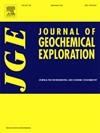贵州诸公堂巨型碳酸盐岩铅锌矿床成矿过程及Ge富集机制——来自硫化物微量元素和同位素组成的约束
IF 3.4
2区 地球科学
Q1 GEOCHEMISTRY & GEOPHYSICS
引用次数: 0
摘要
朱公塘铅锌矿床是四川-云贵成矿区内黔西北地区新发现的巨型铅锌矿床,锌+ Pb品位327万吨,平均锌为6.76%,Pb为2.27%,含Ge 592吨。该矿床赋存于泥盆系、石炭系和二叠系碳酸盐岩中。热液成矿分为3个阶段:(1)黄铁矿-闪锌矿-石英阶段,(2)闪锌矿-方铅矿-黄铁矿-方解石阶段,(3)碳酸盐阶段,确定了3代闪锌矿(Sp-1、Sp-2、Sp-3)。通过对闪锌矿的原位微量元素组成和硫化物的SPb同位素组成的分析,确定了朱公堂矿床的成因和成矿过程。闪锌矿富集Ge(均值= 109 ppm)、Cd(均值= 875 ppm)、Ga(均值= 30 ppm),富集In、Sn、Co,从早期到后期Ge、Cu增加,Mn、Ag、Pb减少。Ge通过3Cu+ + Sb3+ + Ge4+的偶联取代并入闪锌矿中。根据闪锌矿中微量元素浓度估算出闪锌矿的温度和硫逸度(fS2),表明闪锌矿处于中低温和中硫化状态,温度和硫逸度从Sp-1降低到Sp-3。黄铁矿、闪锌矿和方铅矿的δ34S值分别为11.3 ~ 17.8‰、10.2 ~ 17.3‰和8.4 ~ 14.7‰,表明还原硫可能来源于硫酸盐热化学还原(TSR),来源多样。208Pb/204Pb、207Pb/204Pb和206Pb/204Pb的高精度原位Pb同位素比值分别为39.609 ~ 40.230、15.860 ~ 16.042和18.768 ~ 18.984,表明铅主要来源于寄主岩和基底地层。在综合分析矿石地质和地球化学资料的基础上,将朱公塘矿床划分为MVT矿床。随着温度和fS2的逐渐降低,闪锌矿(Sp-2和Sp-3)大量析出,Ge富集显著(平均147 ppm)。本文章由计算机程序翻译,如有差异,请以英文原文为准。

Ore-forming processes of giant carbonate-hosted ZnPb deposit and Ge enrichment mechanism in Zhugongtang, Guizhou Province, China: Constraints from trace element and isotopic compositions of sulfides
The Zhugongtang Zn![]() Pb deposit, with >3.27 million tons of Zn + Pb averaging 6.76 % Zn and 2.27 % Pb, along with 592 tons of Ge, is a newly discovered giant Zn
Pb deposit, with >3.27 million tons of Zn + Pb averaging 6.76 % Zn and 2.27 % Pb, along with 592 tons of Ge, is a newly discovered giant Zn![]() Pb deposit in northwest Guizhou Province of the Sichuan-Yunnan-Guizhou metallogenic region, Southwest China. This deposit is hosted in Devonian, Carboniferous, and Permian carbonate rocks. Three stages of hydrothermal mineralization were identified: (1) the pyrite-sphalerite-quartz stage, (2) the sphalerite-galena-pyrite-calcite stage, and (3) the carbonate stage, and three generations of sphalerite (Sp-1, Sp-2, and Sp-3) were identified. In this study, analyses of in situ trace element compositions in sphalerite and S
Pb deposit in northwest Guizhou Province of the Sichuan-Yunnan-Guizhou metallogenic region, Southwest China. This deposit is hosted in Devonian, Carboniferous, and Permian carbonate rocks. Three stages of hydrothermal mineralization were identified: (1) the pyrite-sphalerite-quartz stage, (2) the sphalerite-galena-pyrite-calcite stage, and (3) the carbonate stage, and three generations of sphalerite (Sp-1, Sp-2, and Sp-3) were identified. In this study, analyses of in situ trace element compositions in sphalerite and S![]() Pb isotopic compositions of sulfides were conducted to determine the origin and mineralization processes of the Zhugongtang deposit. Sphalerite is characterized by enrichment of Ge (mean = 109 ppm), Cd (mean = 875 ppm), and Ga (mean = 30 ppm) and depletion of In, Sn, and Co, with increasing Ge and Cu and decreasing Mn, Ag and Pb from the early to late stages. Ge incorporates into sphalerite via a coupled substitution of 3Cu+ + Sb3+ + Ge4+ ↔ 5Zn2+. The temperature and sulfur fugacity (fS2) are estimated from the trace element concentrations in sphalerite, which indicate medium- to low-temperature and intermediate-sulfidation conditions with decreasing temperature and fS2 from Sp-1 to Sp-3. The pyrite, sphalerite, and galena have δ34S values ranging from 11.3 to 17.8 ‰, 10.2 to 17.3 ‰, and 8.4 to 14.7 ‰, respectively, indicating that the reduced sulfur likely originated from the thermochemical reduction of sulfate (TSR) with multiple sources. High-precision in situ Pb isotope ratios of 208Pb/204Pb, 207Pb/204Pb, and 206Pb/204Pb range from 39.609 to 40.230, 15.860 to 16.042, and 18.768 to 18.984, respectively, which implies that the lead was sourced primarily from the host rock and basement strata. On the basis of a comprehensive analysis of ore geology and geochemical data, the Zhugongtang deposit is classified as an MVT deposit. With the gradual decrease in temperature and fS2, sphalerite (Sp-2 and Sp-3) precipitated in large quantities with significant enrichment of Ge (mean 147 ppm).
Pb isotopic compositions of sulfides were conducted to determine the origin and mineralization processes of the Zhugongtang deposit. Sphalerite is characterized by enrichment of Ge (mean = 109 ppm), Cd (mean = 875 ppm), and Ga (mean = 30 ppm) and depletion of In, Sn, and Co, with increasing Ge and Cu and decreasing Mn, Ag and Pb from the early to late stages. Ge incorporates into sphalerite via a coupled substitution of 3Cu+ + Sb3+ + Ge4+ ↔ 5Zn2+. The temperature and sulfur fugacity (fS2) are estimated from the trace element concentrations in sphalerite, which indicate medium- to low-temperature and intermediate-sulfidation conditions with decreasing temperature and fS2 from Sp-1 to Sp-3. The pyrite, sphalerite, and galena have δ34S values ranging from 11.3 to 17.8 ‰, 10.2 to 17.3 ‰, and 8.4 to 14.7 ‰, respectively, indicating that the reduced sulfur likely originated from the thermochemical reduction of sulfate (TSR) with multiple sources. High-precision in situ Pb isotope ratios of 208Pb/204Pb, 207Pb/204Pb, and 206Pb/204Pb range from 39.609 to 40.230, 15.860 to 16.042, and 18.768 to 18.984, respectively, which implies that the lead was sourced primarily from the host rock and basement strata. On the basis of a comprehensive analysis of ore geology and geochemical data, the Zhugongtang deposit is classified as an MVT deposit. With the gradual decrease in temperature and fS2, sphalerite (Sp-2 and Sp-3) precipitated in large quantities with significant enrichment of Ge (mean 147 ppm).
求助全文
通过发布文献求助,成功后即可免费获取论文全文。
去求助
来源期刊

Journal of Geochemical Exploration
地学-地球化学与地球物理
CiteScore
7.40
自引率
7.70%
发文量
148
审稿时长
8.1 months
期刊介绍:
Journal of Geochemical Exploration is mostly dedicated to publication of original studies in exploration and environmental geochemistry and related topics.
Contributions considered of prevalent interest for the journal include researches based on the application of innovative methods to:
define the genesis and the evolution of mineral deposits including transfer of elements in large-scale mineralized areas.
analyze complex systems at the boundaries between bio-geochemistry, metal transport and mineral accumulation.
evaluate effects of historical mining activities on the surface environment.
trace pollutant sources and define their fate and transport models in the near-surface and surface environments involving solid, fluid and aerial matrices.
assess and quantify natural and technogenic radioactivity in the environment.
determine geochemical anomalies and set baseline reference values using compositional data analysis, multivariate statistics and geo-spatial analysis.
assess the impacts of anthropogenic contamination on ecosystems and human health at local and regional scale to prioritize and classify risks through deterministic and stochastic approaches.
Papers dedicated to the presentation of newly developed methods in analytical geochemistry to be applied in the field or in laboratory are also within the topics of interest for the journal.
 求助内容:
求助内容: 应助结果提醒方式:
应助结果提醒方式:


